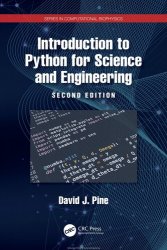Introduction to Python for Science and Engineering, 2nd Edition
- Добавил: literator
- Дата: 15-08-2024, 15:48
- Комментариев: 0
 Название: Introduction to Python for Science and Engineering, 2nd Edition
Название: Introduction to Python for Science and Engineering, 2nd EditionАвтор: David J. Pine
Издательство: CRC Press
Год: 2025
Страниц: 444
Язык: английский
Формат: pdf (true)
Размер: 23.4 MB
Introduction to Python for Science and Engineering offers a quick and incisive introduction to the Python programming language for use in any science or engineering discipline. The approach is pedagogical and “bottom up,” which means starting with examples and extracting more general principles from that experience. No prior programming experience is assumed.
Readers will learn the basics of Python syntax, data structures, input and output, conditionals and loops, user-defined functions, plotting, animation, and visualization. They will also learn how to use Python for numerical analysis, including curve fitting, random numbers, linear algebra, solutions to nonlinear equations, numerical integration, solutions to differential equations, and fast Fourier transforms.
Readers learn how to interact and program with Python using JupyterLab and Spyder, two simple and widely used integrated development environments.
The aim of the second edition remains the same as the first: to provide science and engineering students a practical introduction to technical programming in Python. This new edition adds nearly 100 pages of new material.
A significant disadvantage is that Python programs can be slower than compiled languages like C. For large-scale simulations and other demanding applications, there can be a considerable speed penalty in using Python. In these cases, C, C++, or Fortran are recommended, although intelligent use of Python’s array processing tools in the NumPy module can significantly speed up Python code. Alternatively, several new tools have recently appeared that can be used to speed up certain numerical computations in Python signifcantly, often by one or two orders of magnitude.
All the major Python libraries for science and engineering are covered, including NumPy, SciPy, Matplotlib, and Pandas. Other packages are also introduced, including Numba, which can render Python numerical calculations as fast as compiled computer languages such as C but without their complex overhead.
Скачать Introduction to Python for Science and Engineering, 2nd Edition
Внимание
Уважаемый посетитель, Вы зашли на сайт как незарегистрированный пользователь.
Мы рекомендуем Вам зарегистрироваться либо войти на сайт под своим именем.
Уважаемый посетитель, Вы зашли на сайт как незарегистрированный пользователь.
Мы рекомендуем Вам зарегистрироваться либо войти на сайт под своим именем.
Информация
Посетители, находящиеся в группе Гости, не могут оставлять комментарии к данной публикации.
Посетители, находящиеся в группе Гости, не могут оставлять комментарии к данной публикации.
